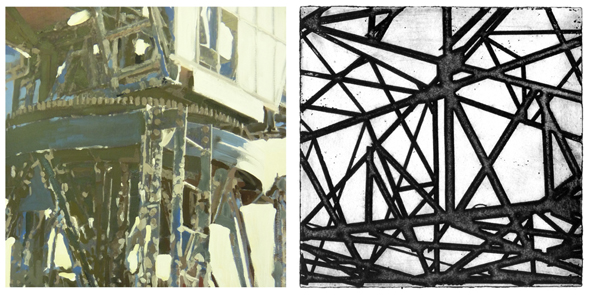תמי סואץ, צילום | סטייסי פילצר, ציור
פגרים בשמים
שישי, 01.02.13 | שעה 12:00

אודות התערוכה
בתערוכה פגרים בשמיים, נוכחותם של טבעי ותעשייתי היא התנגשות בין יופי וכיעור, חיים ומוות, התפעמות ואימה, בריאה והרס. בתוך הערכים של המושגים ’טבע’ ו’תעשייה’ אי אפשר לומר באופן חד משמעי כי כל אחד מהם מייצג באופן אבסולוטי את הטוב או את הרע, את היפה או את המכוער ולעיתים אף קשה להבחין ביניהם.
תהליכי ההרס והניוון של קורוזיה האוכלת בבשר הברזל יוצרים מראות הרמוניים וזאת בזמן שהאובייקט גוסס. תבניות גיאומטריות מרשימות של קונסטרוקציות עמודי חשמל ענקיים מייצגות אובייקט תעשייתי הפוגע בשלוות סביבתו. כבלים פלסטיים בלתי מתכלים מוליכים אנרגיה מחוללת חיים – החשמל.
הקדמה והטכנולוגיה מזמנות לנו התנגשויות ערכיות בין מהות, מראה והתערבות בנוף.
עבודותיה של תמי סואץ לקוחות מתוך פרויקט צילומי בן שלוש שנים, המתעד ומבקר תופעה עולמית, תולדה של הקדמה – החשמל.
סואץ מתייחסת לקונסטרוקציות הברזל של תעשיית החשמל, כאל אחיו העכשוויים של הגולם מפראג, המספקים לאדם אנרגיה (חיים) לקיום בסיסי אך גובים מחיר כבד בנוכחותם הכואבת בנוף הפתוח והאורבני, כמו מזכרות בלתי רצויות לקיום העכשווי. לסואץ יחס אמביוולנטי לענקים הללו. באוסף הצילומים ישנה תחושה תעשייתית רומנטית:
מצד אחד ישנה בצילומים התפעמות מהאלמנטים התעשייתיים, הענקיים, המרשימים בנוכחותם הקונסטרוקטיביסטית.
אך מצד שני, בקומפוזיציות ובאופן הצילום, ישנה עצבות וקינה על השפעתם של אלמנטים תעשייתיים אלו על הנוף ותחושה של רצון עז להקיא את ההרס והפגיעה אותם הם מייצגים.
גוף העבודה מורכב מצילומי עמודי חשמל איוריים, מימיים, נטולי צבע, אפרוריים, כמו נלקחו במאה אחרת, ומהדפסים צילומיים מונוכרומטיים.
סטייסי פילצר מציגה ציורי אקריליק על בד, עשירים במרקם ובצבע.
פילצר מוצאת יופי במבנים תעשייתיים חלודים וזנוחים, הזרוקים כפגרים ברחבי העיר וחותכים את השמיים. המכונות שהחלידו עברו טרנספורמציה לתפקיד אחר. עודן עוצמתיות, מקובצים בתוכן גלגלי שיניים קפואים. דרך ציור תהליכי הקורוזיה של הברזל, נוקשות ועייפות החומר והקונסטרוקציות האימתניות, משלבת פילצר בין המרחב העירוני לנוף פנימי.
בעקבות התערוכה פגרים בשמיים, מסקרן להיזכר במניפסט הפוטוריסטי ובתפישתו את הנוכחות התעשייתית כאסתטיקה נשגבה:
”…היינו ערים כל הלילה, חבריי ואני, ישבנו תחת מנורות מסגד. כיפות הנחושת של המנורות בהקו כמו נפשותינו אנו, כי כמוהן גם אנחנו הוארנו באור פנימי של לבבות חשמליים…
אנחנו חייבים לפרוץ את שערי החיים ולנסות את הברגים והמנעולים…
הו! שוחה אימהית, מהולה במי בוץ! מי שופכין תעשייתיים! בפה מלא התענגתי על הרקבובית המחזקת שהזכירה לי את שדיה השחורים של האומנת הסודנית שלי…”
מתוך המניפסט הפוטוריסטי, פיליפו טומאסי מרינטי, 1909.
אוצרת התערוכה: רותם ריטוב
שיח גלריה: שבת, 16.02.13 | שעה 11:00
נעילת התערוכה: 03.03.2013
Tami Suez | Stacey Piltzer
Celestial Cadavers
Friday 01.02.13 | at 12:00
The image hints on one hand, to the interior of a family home, an intimate, protective territory, and a happy festive occasion. On the other hand, it provides no information regarding the people or occasion that occurred. The emphasis is on unattended presence, documentary fragments of nostalgic memory.
The celebration’s starting point evolves into a continuous investigation exploring themes such as petty-bourgeois environment, family affairs, boundaries, aspirations and disillusionment. The personal/family axis intersects the cultural/materialistic axis regarding birthday parties and other happy occasions that relate to feelings, intimacy, and a disillusioned observation of reality vs. expectation.
Gilboa cuts the images from ‘Marie Claire–Maison’, the French magazine dedicated to the “perfect” bourgeois house (a magazine held sacred by its collectors). The paper clips enable her to create the home and the fractured birthday experience. The action of cutting and pasting is present, and allows the exchange of one reality for another. The creation of a fantastic, enchanted collage whose fractures result from the shattering of the festive fantasy and its reconstruction. Gilboa explores the relations between the two and three dimensional. She examines the borders between them, dismantling and reconstructing a totally different structure and reality. What’s hidden at first glance, materializes at further observation. That’s when the torn, ripped, glued and filth emerge.
The elements of the petty-bourgeois house imply a particular status and taste. They reflect a certain design perception which views the house as a platform expressing its owner’s esthetic taste, while they might otherwise be perceived as tasteless kitsch. The collage generates a critique emerging out of a fresh examination of the elements, and an attempt to decrypt them. A chilling moment materializes addressing another contemporary cultural question – Is this a beautiful or a fake world? Does the acquisition of the bourgeois elements of the “perfect” house actually award a promised perfection?
Transitions between a private, biographical world and a world of consumerism and commercials, issues of interior and exterior, and the way memories and expectations are created – all these are clustered into a compassionate picture of solitude.
This exhibition is a direct extension of Gilboa’s preoccupation and exploration in previous work. She returns time and again to the house and its cracked corners, to the “dirty” places. She positions the safe border alongside the dangerous, unsettling one. The exploration of the human space and presence.
In “On the Fingertips” – her 2009 exhibition at the Tel Aviv Artists House , she displayed pictures of her daughters’ rooms alongside body-parts and personal objects hinting to a certain state-of-mind, adolescence, separation and cautious investigation, “on the fingertips” of their environment.
In her “30 cc” exhibition the location examination expanded into presenting photo albums, while the actions of “placing” and cutting the object were the focal point of the studio installation. Various objects united together into an alternately enigmatic or non-literal statement.
Curated by: Rotem Ritov
Gallery Talk: Saturday 16.02.13 | at 11:00
Closing: 03.03.13
